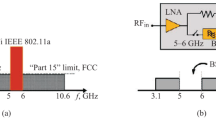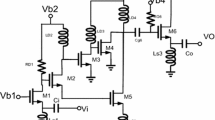Abstract
In order to improve the out-of-band interference filtering in the front-end of a wideband radio frequency system, this paper proposes a two-stage low-noise amplifier (LNA) that has three notches in its transfer function. In the proposed LNA, two center-tap inductors are utilized, where the center-tap inductor is modeled as two equal inductors with a mutual coupling. Here, by properly designing these two inductors and their coupling, in the utilized two center-tap inductors, three notches and proper peaking in the transfer function of the LNA, as well as input matching, are simultaneously realized. The proposed LNA is fabricated in 65 nm CMOS, and its active area is 0.13 mm2. The LNA shows three notches at 2.9 GHz, 13.1 GHz and 17.2 GHz. Moreover, the 3 dB BW is from 5.4 GHz to 8.7 GHz, sufficiently wide to operate in the worldwide ultra-wideband (UWB) regulated spectrum. The proposed LNA power consumption is 9.9 mW from a 1.1 V supply, with a minimum noise figure of 3.4 dB and a gain of 24.8 dB.











Similar content being viewed by others
Data Availability
All data generated or analyzed during this study are included in this published article.
References
M. Battista, J. Gaubert, M. Egels, S. Bourdel, H. Barthélémy, High-voltage-gain CMOS LNA for 6–8.5 GHz UWB receivers. IEEE Trans. Circuits Syst. II Express Briefs 55(8), 713–717 (2008)
J.F. Chang, Y.S. Lin, 0.99 mW 3–10 GHz common-gate CMOS UWB LNA using T-match input network and self-body bias technique. Electron. Lett. 47(11), 658–659 (2011)
J.F. Chang, Y.S. Lin, 3.2-9.7 GHz ultra-wideband low-noise amplifier with excellent stop-band rejection. Electron. Lett. 48(1), 44–45 (2012)
J.F. Chang, Y.S. Lin, Complementary current-reused 3.7–11.9 GHz LNA using body-floating and self-bias technique for sub-6 GHz 5G communications. Circuits Syst. Signal Process. 1–22, 5968–5989 (2022)
B. Guo, X. Li, A 1.6–9.7 GHz CMOS LNA linearized by post distortion technique. IEEE Microwave Wirel. Compon. Lett. 23(11), 608–610 (2013)
J. Jang, H. Kim, G. Lee, T.W. Kim, Two-stage compact wideband flat gain low-noise amplifier using high-frequency feedforward active inductor. IEEE Trans. Microw. Theory Tech. 67(12), 4803–4811 (2019)
M. Lee, K. Ickjin, 3–10 GHz noise-cancelling CMOS LNA using gm-boosting technique. IET Circuits Dev. Syst. 12(1), 12–16 (2018)
N. Li, W. Feng, X. Li, A CMOS 3–12 GHz Ultra-wideband low noise amplifier by dual-resonance network. IEEE Microw. Wirel. Compon. Lett. 27(4), 383–385 (2017)
Y. Li, X. Li, Z. Huang, T. Tan, D. Chen, C. Cao, Z. Qi, A novel low-power notch-enhanced active filter for ultrawideband interferer rejected LNA. IEEE Trans. Microw. Theory Tech. 69(3), 1684–1697 (2021)
Z. Li, B. Liu, Y. Duan, Z. Wang, Z. Li, Y. Zhuang, Flat high gain design and noise optimization in SiGe low-noise amplifier for S-K band applications. Circuits Syst. Signal Process. 40(6), 2720–2740 (2021)
C.P. Liang, P.Z. Rao, T.J. Huang, S.J. Chung, Analysis and design of two low-power ultra-wideband CMOS low-noise amplifiers without-band rejection. IEEE Trans. Microw. Theory Tech. 58(2), 277–286 (2010)
J.Y. Lin, H.K. Chiou, Power constrained third-order active notch filter applied in IR-LNA for UWB standards. IEEE Transactions on Circuits and System II: Express Briefs 58(1), 11–15 (2011)
C.Y. Lin, C.P. Liang, J.H. Tarng, S.J. Chung, Compact composite noise-reduction LNA for UWB WPAN and WBAN applications. IET Microw. Antennas Propag. 12(6), 903–908 (2018)
Y.S. Lin, C.C. Wang, G.L. Lee, C.C. Chen, High-performance wideband low—noise amplifier using enhanced π-match input network. IEEE Microwave Wirel. Compon. Lett. 24(3), 200–202 (2014)
B. Park, S. Choi, S. Hong, A low-noise amplifier with tunable interference rejection for 3.1 to 10.6-GHz UWB systems. IEEE Microwave Wirel. Compon. Lett. 20(1), 40–42 (2010)
M. Parvizi, K. Allidina, M.N. El-Gamal, A sub—mw, ultra—low—voltage, wideband low—noise amplifier design technique. IEEE Trans Very Larg-Scale Int (VLSI) Syst 23(6), 1111–1122 (2015)
B. Razavi, RF Microelectronics, vol. 2 (Prentice Hall, New York, 2012)
B. Razavi, Fundamentals of microelectronics (John Wiley & Sons, 2013)
S.S. Regulagadda, B.D. Sahoo, A. Dutta, K.Y. Varma, V.S. Rao, A packaged noise-canceling high-gain wideband low noise amplifier. IEEE Trans. Circuits Syst. II Express Briefs 66(1), 11–15 (2019)
SPARK SR1020 UWB Wireless transceiver, spark microsystems Inchttps://www.sparkmicro.com/products/
A. Taibi, M. Trabelsi, A. Slimane, A.A. Saadi, M.T. Belaroussi, Efficient UWB low noise amplifier with high out of band interference cancellation. IET J. Microwave Antennas Propagation 11(1), 98–105 (2017)
Funding
There is no funding for this manuscript.
Author information
Authors and Affiliations
Corresponding author
Ethics declarations
Conflict of Interest
There is no conflict of interest for this manuscript.
Additional information
Publisher's Note
Springer Nature remains neutral with regard to jurisdictional claims in published maps and institutional affiliations.
Appendix A
Appendix A
This appendix shows the details of the KCL equations to derive the input–output transfer function of the 1st stage of the proposed LNA. Considering the circuit model of the 1st LNA stage, shown in Fig. 3, the following can be written:
Note that, here, k1 is the coupling factor between the two inductors in L1 and L2, and M1 and M2 are the resulting mutual inductances. Moreover, RS is the source impedance of 50 Ω. The resulting transfer functionVo1/Vin has 6 poles and 4 zeros. Considering a third-order s-domain transfer function for the numerator and denominator results in:
where
Rights and permissions
Springer Nature or its licensor (e.g. a society or other partner) holds exclusive rights to this article under a publishing agreement with the author(s) or other rightsholder(s); author self-archiving of the accepted manuscript version of this article is solely governed by the terms of such publishing agreement and applicable law.
About this article
Cite this article
Ghamati, M., Taherzadeh, M. & Nabki, F. A Compact Wideband Two-Stage LNA with Multiple Notches for Out-of-Band Filtering Using Center-Tap Inductors. Circuits Syst Signal Process 42, 2573–2588 (2023). https://doi.org/10.1007/s00034-022-02254-6
Received:
Revised:
Accepted:
Published:
Issue Date:
DOI: https://doi.org/10.1007/s00034-022-02254-6




